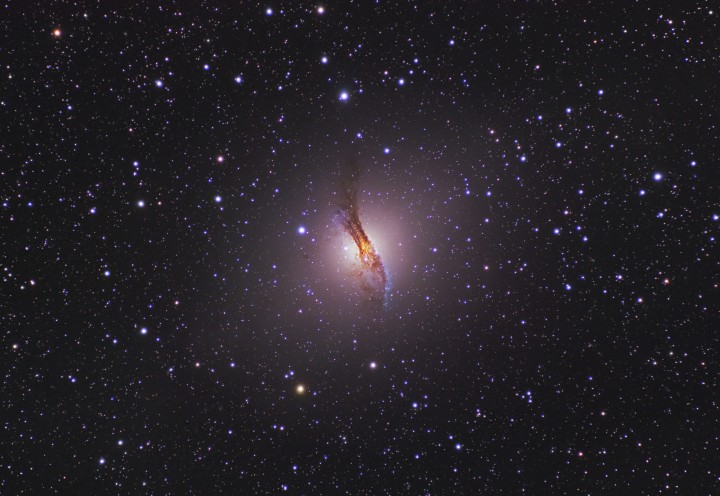
|
Credit & Copyright: Robert Gendler and
Stephane Guisard
Explanation:
At the center of
this
sharp skyscape, Centaurus A seems to be
a fantastic jumble of old yellow stars, young blue star clusters,
and imposing dark dust lanes.
Spanning over 60,000 light-years,
the
peculiar elliptical galaxy is
apparently the result of a collision of two otherwise
normal galaxies.
The left over cosmic debris is steadily being consumed by a
black
hole with a billion times the mass of the Sun which lies
at the center of Centaurus A.
It's likely that such
black
hole central engines generate the
radio, X-ray, and gamma-ray energy radiated
by Centaurus A and other
active
galaxies.
For an active galaxy Centaurus A
is close, a mere 10 million
light-years away,
and is well-studied by
earthbound
astronomers.
Check out:
Venus and Saturn in tonight's evening sky.
|
January February March April May June July August September October November December |
| ||||||||||||||||||||||||||||||||||||||||||||||||
NASA Web Site Statements, Warnings, and Disclaimers
NASA Official: Jay Norris. Specific rights apply.
A service of: LHEA at NASA / GSFC
& Michigan Tech. U.
Based on Astronomy Picture
Of the Day
Publications with keywords: active galaxy - black hole
Publications with words: active galaxy - black hole
See also:
- APOD: 2025 December 3 Á Visualization: Near a Black Hole and Disk
- APOD: 2025 December 2 Á M77: Spiral Galaxy with an Active Center
- APOD: 2025 September 24 Á GW250114: Rotating Black Holes Collide
- APOD: 2025 May 9 Á IXPE Explores a Black Hole Jet
- APOD: 2025 May 6 Á The Doubly Warped World of Binary Black Holes
- APOD: 2025 May 4 Á Spin up of a Supermassive Black Hole
- APOD: 2024 December 11 Á The Shells and Jets of Galaxy Centaurus A
